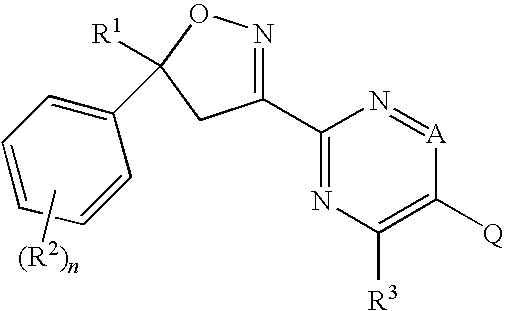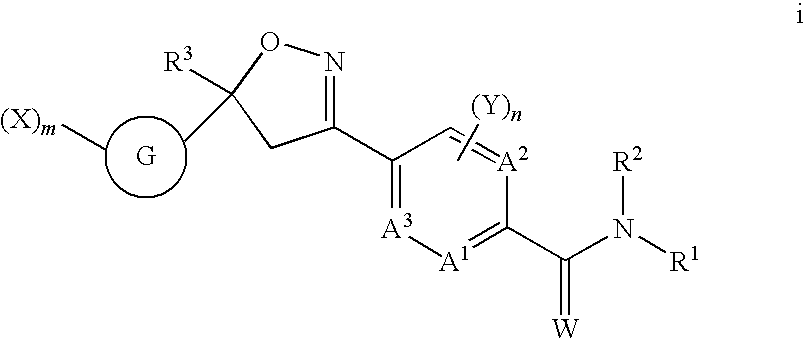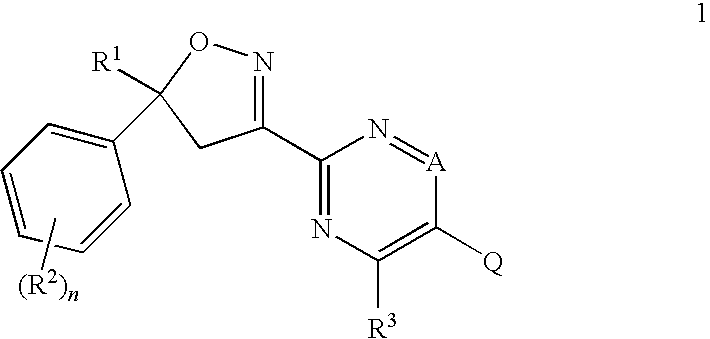Isoxazolines for Controlling Invertebrate Pests
a technology of invertebrate pests and isoxazolines, which is applied in the field of isoxazolines, can solve the problems of increasing consumer costs and significant productivity reduction
- Summary
- Abstract
- Description
- Claims
- Application Information
AI Technical Summary
Benefits of technology
Problems solved by technology
Method used
Image
Examples
example 1
Preparation of 2-[5-(3,5-dichlorophenyl)-4,5-dihydro-5-(trifluoromethyl)-3-isoxazolyl]-4-methyl-N-(2,2,2-trifluoroethyl)-5-pyrimidinecarboxamide
Step A: Preparation of Ethyl 2-(diethoxymethyl)-4-methyl-5-pyrimidinecarboxylate
[0180]A solution of ethyl 2-[(dimethylamino)methylene]-3-oxobutanoate (see J. Heterocyclic Chem. 1987, 24, 1669 for preparation) (1.85 g, 0.01 mol) in ethanol (10 mL) was added to a mixture of 2,2-diethoxyethanimidamide monohydrochloride (also known as diethoxyacetamidine hydrochloride) (see J. Org Chem. 1961, 26, 412 for preparation) (1.45 g, 0.01 mol) and sodium ethoxide (3.15 mL of 21% in ethanol). The reaction mixture was heated at reflux for 18 h. The resulting mixture was concentrated under reduced pressure, and the residue was suspended in water, followed by extraction with dichloromethane (2×50 mL). The organic extracts were dried (MgSO4) and concentrated under reduced pressure to afford the title compound as a yellow oil (2.3 g).
[0181]1H NMR (CDCl3): δ 9...
example 2
Preparation of 2-[5-(3,5-dichlorophenyl)-4,5-dihydro-5-(trifluoromethyl)-3-isoxazolyl]-4-methyl-N-(2-pyridinylmethyl)-5-pyrimidinecarboxamide
Step A: Preparation of 2-(diethoxymethyl)-4-methyl-5-pyrimidinecarboxylic Acid
[0191]To a solution of ethyl 2-(diethoxymethyl)-4-methyl-5-pyrimidinecarboxylate (i.e. the product from Step A, Example 1) (2.68 g, 0.01 mol) in tetrahydrofuran (15 mL) was added 1 N aqueous sodium hydroxide (15 mL). The reaction mixture was stirred at room temperature for 18 h, then extracted with diethyl ether (2×10 mL), and the aqueous layer was acidified with 1 N aqueous hydrochloric acid to pH 5 and extracted with dichloromethane (2×10 mL). The dichloromethane extracts were dried (MgSO4) and concentrated under reduced pressure to provide the title compound as a white solid (2 g).
[0192]1H NMR (CDCl3): δ 9.33 (s, 1H), 5.6 (s, 1H), 3.8 (q, 2H), 3.77 (q, 2H), 2.92 (s, 3H), 1.3 (t, 3H), 1.28 (t, 3H).
Step B: Preparation of 2-(diethoxymethyl)-4-methyl-5-pyrimidinecarbon...
example 3
Preparation of 2-[5-(3,5-dichlorophenyl)-4,5-dihydro-5-(trifluoromethyl)-3-isoxazolyl]-5-(1H-1,2,4-triazol-1-yl)-4-(trifluoromethyl)pyrimidine
Step A: Preparation of 4-(dimethylamino)-1,1,1-trifluoro-3-(1H-1,2,4-triazol-1-yl)-3-buten-2-one
[0200]A mixture of 3-bromo-1,1,1′-trifluoro-2-propanone (4.00 g, 0.02 mol) and 1H-1,2,4-triazole (1.7 g, 0.02 mol) in isopropanol (20 mL) was heated at reflux for 4 h, and then concentrated under reduced pressure to provide a solid. To a solution of the solid dissolved in water (5 mL) and concentrated hydrochloric acid (3.63 mL) was added a solution of sodium nitrite (1.6 g, 0.024 mol) in water (5 mL) dropwise over 15 minutes at 5° C. The reaction mixture was stirred for 1 h at room temperature, then water (25 mL) was added and stirring was continued for an additional 15 minutes. The aqueous mixture was extracted with ethyl acetate (2×25 mL), and the combined organic extracts were dried (MgSO4), filtered and concentrated under reduced pressure to gi...
PUM
| Property | Measurement | Unit |
|---|---|---|
| temperature | aaaaa | aaaaa |
| diameters | aaaaa | aaaaa |
| particle diameters | aaaaa | aaaaa |
Abstract
Description
Claims
Application Information
 Login to View More
Login to View More - R&D
- Intellectual Property
- Life Sciences
- Materials
- Tech Scout
- Unparalleled Data Quality
- Higher Quality Content
- 60% Fewer Hallucinations
Browse by: Latest US Patents, China's latest patents, Technical Efficacy Thesaurus, Application Domain, Technology Topic, Popular Technical Reports.
© 2025 PatSnap. All rights reserved.Legal|Privacy policy|Modern Slavery Act Transparency Statement|Sitemap|About US| Contact US: help@patsnap.com



